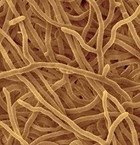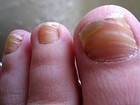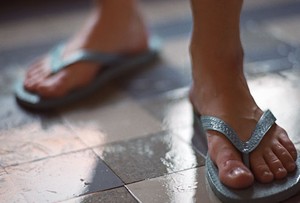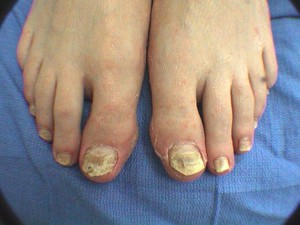Home » Faq Hair Removal » Nail Fungus
Does Your Toenail Fungus Have You Hostage On The Beach?
It is estimated that approximately 10% of the population has issues with toenail and fingernail fungus. Below you will find some of the most commonly asked questions on nail fungus and how to treat this embarrassing and annoying infection.
I have no doubt that after you have gone through our website that you may have many more questions that need to be answered, but there's no need to worry. Should you in fact have any further question about our Nail Fungus Laser Treatments, then I invite you to contact us via email, or at our office. There's no need for you to keep burying your feet in the sand any longer while everyone else is enjoying the beach.
What Is Nail Fungus?
Nail fungus is a microorganism called a dermatophyte(s). Dermatophytes are the same type of fungus that can cause athlete's foot; however, in this case the dermatophytes find their way under the nail bed.
The fungus can grow, thrive, and even spread throughout the nail bed and then spread to other toenails resulting in a total toenail fungus infestation.
What Are Some Symptoms Of Nail Fungus Infections?
Symptoms vary; however, they usually begin with a yellowing of the nail. This discoloration may also be whitish and/or opaque and may even be brown, green, or black in color.
Additionally, along with the discoloration of the nail, it may also begin to thicken or become very brittle and start to flake away in small chips along the periphery of the infected nail or infected nail beds.
How Does Fungus Infect The Nail?
Fungus can be found virtually everywhere. It thrives in dark moist areas and feeds off of keratin. Preventing fungal exposure in public pools, locker-rooms, or dirty showers is relatively simple by wearing sandals, and keeping your feet clean; however, you may be under increased susceptibility to fall victim to a severe fungal infection if you do not take the proper precautions.
Your feet are the perfect breeding ground for fungal infections, and your nails are made up of keratin which provides the fungus the needed fuel for the infection to grow and spread. Toenail fungus often begins as athlete's foot and works its way deep underneath the nail through a break in the skin. Once you have been exposed to the fungi, the fungus works its way underneath the nail and imbeds itself within deep within the nail bed and begins to feed off of the keratin in the nail.
Can Toenail And Fingernail Fungus Be Treated With A Laser?
 Yes, nail fungus can be treated with a laser, regardless of whether the fungus is in a fingernail or toenail. The key in treating nail fungus infections is to immediately take a proactive approach once the infection is noticed. Keeping the area clean and dry may not take care of the fungus, and many over the counter fungal creams and ointments may not be able to penetrate deep enough into the nail bed to eliminate fungal infections.
Yes, nail fungus can be treated with a laser, regardless of whether the fungus is in a fingernail or toenail. The key in treating nail fungus infections is to immediately take a proactive approach once the infection is noticed. Keeping the area clean and dry may not take care of the fungus, and many over the counter fungal creams and ointments may not be able to penetrate deep enough into the nail bed to eliminate fungal infections.
Additionally, treating nail fungus can also been done with prescription medications; however, many prescription medications have adverse side effects and can be very dangerous and harmful to the human body when used to treat nail fungus. These side effects include but are not limited to: harming the liver, or kidneys and may require repeated blood work by your doctor.
How Many Nail Fungus Laser Treatments Will I Need?
The number of treatments depends on the severity of the infection. Typically, all ten toenails are treated during each laser treatment. This is done so as to ensure that the infection doesn't spread to uninfected areas, or reinfect areas that have already been treated.
Treatments should be repeated every 4 to 6 weeks until the infection has been completely eradicated, and the nail is clear and free from the nail fungal infection. By doing so, this allows the treated nail fungus areas to heal and also ensures that the fungus does not have an opportunity to resurface and/or reinfect any of the nail beds again between treatments.
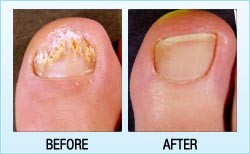 What Should I Expect During Treatments, And How Long Will It Take To See Results?
What Should I Expect During Treatments, And How Long Will It Take To See Results?
Most clients feel very little to no pain. Some clients feel a warming sensation, and an isolated few may feel a slight pinprick or tingle during their treatments.
Laser treated nails will generally completely grow out and replace themselves between 6 and 12 months; however, most clients usually notice new healthy nail growth within the first 3 months.
How Can I Guarantee My Chances Of Success In Curing A Nail Fungal Infection?
 The key to ensuring your chances of successfully curing a nail fungus infection is quite simple, and depends on several things. The first is the severity of the nail fungal infection. The second is the individuals willingness to commit themselves to the nail fungal treatments.
The key to ensuring your chances of successfully curing a nail fungus infection is quite simple, and depends on several things. The first is the severity of the nail fungal infection. The second is the individuals willingness to commit themselves to the nail fungal treatments.
Simply trying to treat the infection a couple of times is futile, and will ultimately lead to the reinfection of the nail bed once again. The recurrence of nail fungus infections is extremely common. Studies have shown that 20 percent of individuals will experience a recurrence of nail fungus infections as a result of not following through with their laser nail treatment regimen.
Laser nail fungus treatments should be repeated every 4 to 6 weeks until the nail fungus infection has been completely eradicated, and the nail is clear and free from nail fungus infections.


